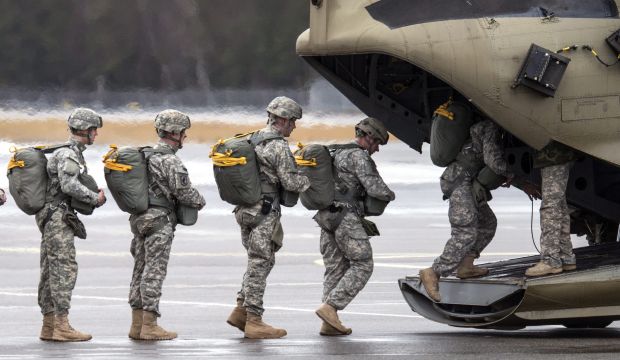
Paratroopers of the US Army enter a helicopter at the training area in Grafenwöhr, Germany, on February 10, 2014. (EPA/Armin Weigel)
Brussels, Reuters—The United States plans by the end of next year to station around 150 tanks and armored vehicles in Europe for use by US forces training in Europe as part of the US response to the Ukraine crisis, according to a US military commander.
Some of the tanks and vehicles—enough to equip an armored brigade—could be “pre-positioned” in Poland, Romania or the Baltic states, Lt. Gen. Ben Hodges, commander of the US Army in Europe, said in a telephone interview with Reuters from Wiesbaden, Germany.
The United States and NATO partners have reinforced eastern Europe and have stepped up exercises to reassure newer members of the alliance made nervous by what they see as Russian assertiveness. Russia denies any aggressive activity.
Hodges said he expected the US contribution to this, known as “Operation Atlantic Resolve,” to go on throughout 2015 and into 2016.
Keeping enough equipment in Europe for a US armored brigade avoids the need for troops coming from the United States for exercises to bring their own kit.
It also means the equipment is there if the United States needed to reinforce eastern Europe quickly in an emergency.
“By the end of . . . 2015, we will have gotten all the equipment for a heavy brigade, that means three battalions plus a reconnaissance squadron, the artillery headquarters, engineers, and it will stay in Europe,” Hodges said.
“You are talking about 150-ish, maybe 160 M1 tanks, M2 Bradley fighting vehicles, 24 self-propelled howitzers.”
No decision has yet been taken on where the armored vehicles will be kept.
Hodges said he expected at least a third of it to remain at US training centers in Germany. The United States could consider distributing some of the equipment to a Baltic country, Poland or Romania if it made strategic sense and if that country wanted it kept there.
The United States has sharply cut its forces in Europe since the Cold War. It now has about 30,000 troops there plus a similar number of Air Force, Navy and Marine personnel, Hodges said.
Despite budgetary pressures in the United States, Hodges said he hoped US soldiers and bases in Europe would remain at their current levels for now.
Hodges said he believed there was a risk that pro-Russian separatists in eastern Ukraine, where a ceasefire has been agreed but regularly broken, could launch a new offensive in the spring.
